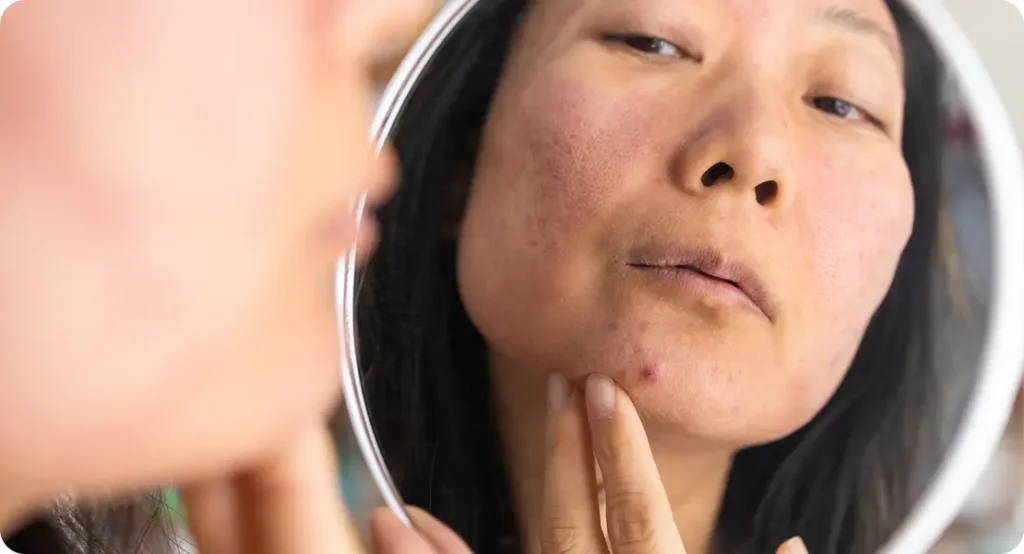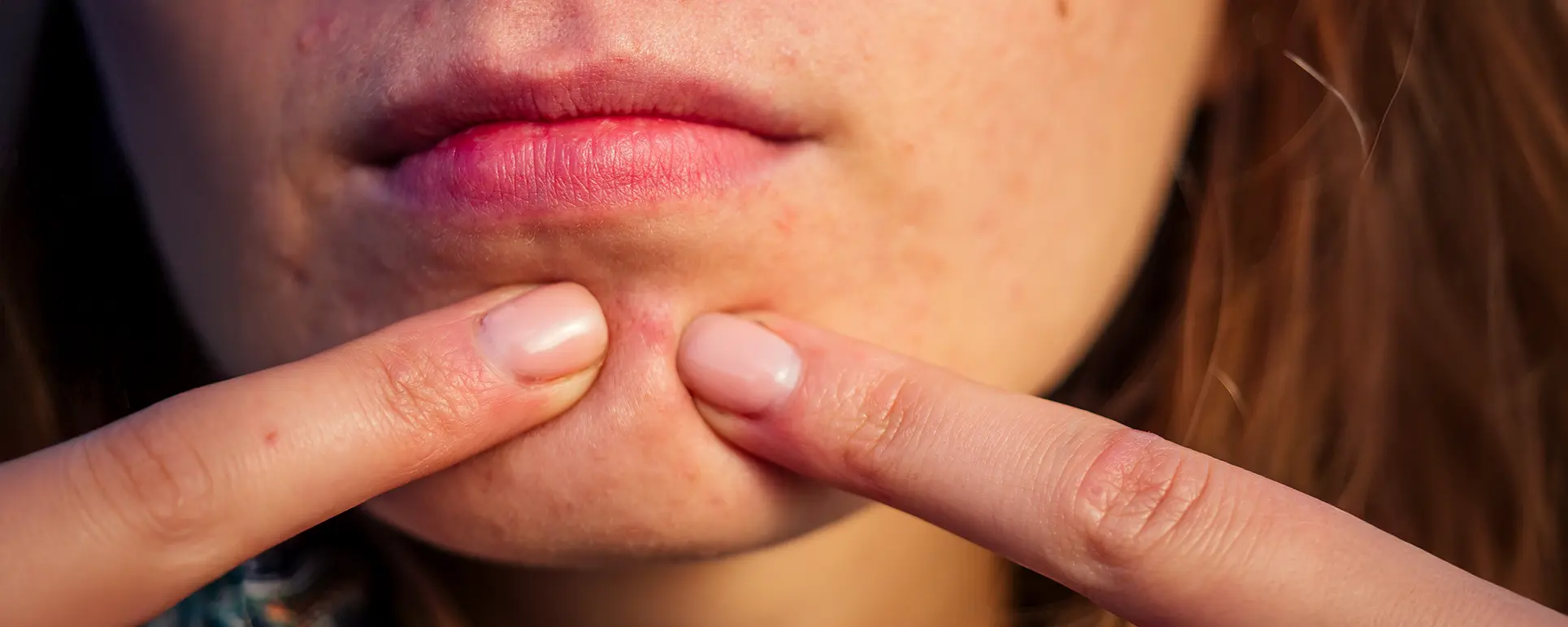Many people notice that breakouts seem to reappear in the exact same areas whether it’s on the chin, across the forehead, or dotted along the cheeks. It can feel incredibly frustrating when you’ve just managed to clear a spot, only for another one to appear in the very same place weeks later. This isn’t just bad luck or coincidence. There are several underlying reasons why certain areas of your skin are more prone to repeated flare-ups, and understanding these can help you take better control of your acne.
One of the most common explanations is that some parts of the face naturally produce more oil than others. The forehead, nose, and chin known together as the T-zone have a higher concentration of sebaceous glands. These glands can become overactive, producing excess sebum that mixes with dead skin cells and bacteria, clogging pores again and again. If you find your breakouts are always in these areas, oily skin could be the main culprit.
Hormones also play a big role. For many people, fluctuations during puberty, monthly cycles, or even times of stress cause the skin to react. Increased hormone levels stimulate oil production and inflammation, making certain areas especially the chin and jawline hotspots for persistent breakouts. This is why some women notice spots reliably appearing in the same areas each month. Another factor is that once a pore has been inflamed by a spot, it may remain weakened. If the deeper blockage inside the follicle isn’t fully cleared, the pore can easily become clogged again, leading to repeat breakouts in the same location. Think of it as a “trouble spot” that is more sensitive and more likely to flare up once irritated.
Everyday habits can make matters worse without you realising. Frequently touching your face, leaning your chin on your hands, using unwashed makeup brushes, or not changing pillowcases often enough can all transfer bacteria and oils back to the same areas of skin. These little actions may seem harmless, but they create the perfect environment for spots to keep coming back.
In some cases, recurring spots may point to deeper skin conditions such as cystic acne. Unlike surface-level pimples, cystic acne forms deep under the skin and often reappears in the same places because the infection is lodged further down in the follicle. These spots can be painful, slow to heal, and more likely to scar if not treated properly.
If you find that the same patches of skin are affected over and over again, it’s a clear sign that simple over-the-counter creams may not be enough. Professional guidance can help break the cycle. Visiting an Acne Clinic in London gives you access to personalised assessments, advanced treatments such as chemical peels or laser therapy, and expert advice on how to prevent future flare-ups. By addressing both the visible spots and the underlying triggers, you can finally achieve clearer, healthier skin and reduce the chances of spots constantly returning in the same place.
1. Common Causes of Recurring Spots

Hormonal Fluctuations
Hormones are one of the most powerful influences on our skin, and fluctuations often explain why breakouts keep showing up in the same areas. Androgens, a type of hormone, stimulate the sebaceous glands, leading them to produce more oil. When too much oil is released, it combines with dead skin cells and bacteria, blocking pores and sparking inflammation. This is why you might notice that spots cluster around the chin, jawline, and lower face these areas are particularly sensitive to hormonal activity.
Women often experience recurring breakouts before or during their menstrual cycles because of hormone changes. Similarly, teenagers going through puberty or adults under high stress may notice flare-ups tied to surges in androgen or cortisol levels. Even conditions like polycystic ovary syndrome (PCOS) can cause stubborn, repeat breakouts along the same facial zones. Because hormones naturally cycle, the breakouts often do as well, giving the impression that spots are “returning” to the same locations over and over again.
Clogged Pores
Clogged pores are another common reason behind recurring spots. Our skin naturally sheds dead cells, but when these cells aren’t cleared efficiently, they can mix with oil and bacteria to form a blockage. Once a pore has become inflamed, the follicle wall may be damaged, leaving it vulnerable to becoming clogged again in the future. This means the same pore and therefore the same patch of skin is more likely to flare up repeatedly.
The forehead, nose, and chin are particularly prone to clogged pores because these areas contain a higher number of sebaceous glands. That’s why many people notice the same regions developing comedones, such as blackheads and whiteheads, time and again. Even if the visible spot disappears, if the deeper congestion inside the pore isn’t fully addressed, it often resurfaces as another breakout in the same place.
Friction or Pressure
Friction-related acne, also called acne mechanica, develops when constant pressure or rubbing irritates the skin and triggers inflammation. Everyday behaviours and environments can unintentionally cause this kind of irritation. For example, leaning your chin on your hands while working, wearing helmets or sports gear that presses against the skin, or even wearing face masks for long periods of time can trap sweat, heat, and oil in the same spots.
Because the skin is being continually disturbed in those exact areas, breakouts triggered by friction often reappear in the same locations. Athletes, for example, frequently notice recurring spots along the hairline, jawline, or forehead where helmets and straps make contact. Similarly, people who wear glasses may find small breakouts keep appearing on the bridge of the nose where the frames rest. Without removing or reducing the source of friction, these spots are likely to keep coming back.
Lifestyle and Habits
The way we live also plays a major role in recurring acne. A diet high in refined sugar, processed foods, or dairy can spike insulin levels and fuel inflammation, which worsens acne for some people. Poor sleep and chronic stress disrupt the body’s hormone balance, slowing down skin healing and making it easier for spots to reappear in the same areas.
Daily habits matter just as much. Touching your face without realising, resting your head on your hands, or using a mobile phone directly against your cheek can all transfer bacteria and oils that trigger breakouts. Skincare routines can also be a hidden cause. Using products that contain comedogenic ingredients, skipping cleansing at night, or constantly switching between new skincare products can irritate the skin and keep certain areas breaking out. Even something as simple as not washing pillowcases and makeup brushes frequently enough can encourage bacteria to linger, leading to spots repeatedly forming in the same place.
2. When to See a Dermatologist

While occasional spots are common and can often be managed at home, there comes a point where professional help is the best option. If you’re finding that the same areas of your skin continue to break out no matter what products you use, or if your acne is becoming more painful or leaving marks behind, it may be time to see a dermatologist. Early intervention not only helps clear your skin faster but also reduces the risk of long-term scarring or skin damage.
Here are some clear signs that it’s worth seeking expert advice:
- Spots persist despite consistent skincare routines
If you’ve been following a good skincare routine cleansing twice daily, using non-comedogenic products, and incorporating acne treatments like salicylic acid or benzoyl peroxide yet still struggle with breakouts in the same areas, it suggests the issue may be more complex. Persistent acne can often be tied to hormonal imbalances, genetics, or deeper skin inflammation that over-the-counter solutions simply can’t address. - Acne leaves scarring or dark marks
One of the biggest risks of untreated or recurring acne is the damage it leaves behind. Even small, repeated spots in the same place can cause long-term changes such as post-inflammatory hyperpigmentation (dark patches) or pitted scars. These marks are often far more difficult to treat than the acne itself. Seeking professional care before scarring develops can protect the overall health and appearance of your skin. - Breakouts are painful, cystic, or severe
Unlike surface-level pimples, cystic acne forms deep within the skin. It is usually red, swollen, and painful to touch, and often comes back in the same locations. Cystic spots are much harder to manage at home and have a much higher chance of leaving permanent scars. If you regularly experience this type of acne, seeing a dermatologist is strongly recommended. - Acne affects your confidence or daily life
Beyond the physical symptoms, acne can also take a toll on self-esteem. If repeated breakouts are making you feel anxious, embarrassed, or less confident in social situations, professional treatment can not only improve your skin but also your overall quality of life.
Visiting an Acne Clinic in London gives you access to treatments that are tailored to your specific skin type and concerns. Dermatologists may recommend:
- Prescription topical treatments such as retinoids or stronger antibacterial creams that work deeper in the pores than over-the-counter products.
- Oral medications like antibiotics to target bacteria and inflammation, or hormonal treatments (such as the contraceptive pill or spironolactone) to regulate oil production in hormone-related acne.
- In-clinic procedures including chemical peels, light or laser therapy, and extractions to help clear stubborn pores and speed up skin renewal.
- Personalised lifestyle advice to identify diet, stress, or skincare triggers that could be contributing to recurring spots.
By working with a dermatologist, you gain a treatment plan designed not just to clear existing acne, but also to prevent it from coming back in the same places. This long-term approach is often the key difference between short-term relief and lasting clear skin.
3. Skincare Products and Comedogenic Ingredients
Sometimes, the very products you rely on to improve your skin can be contributing to recurring breakouts. Many creams, serums, sunscreens, and makeup items contain comedogenic ingredients substances that are more likely to clog pores. When these products are applied to areas that are already prone to oiliness, such as the forehead, chin, and nose, they can trap sebum, dead skin cells, and bacteria inside the pores, creating the perfect conditions for acne to return in the same locations repeatedly.
Heavy or Oily Products Can Worsen Breakouts
Products that are thick, greasy, or oil-based, even if marketed as nourishing or hydrating, can inadvertently block pores. Ingredients such as coconut oil, lanolin, isopropyl myristate, cocoa butter, and some silicones can be particularly problematic for acne-prone skin. While they may feel luxurious or moisturising, they increase the likelihood of clogged pores in sensitive areas. Similarly, makeup foundations or sunscreens that are not specifically designed for oily or acne-prone skin can act as an additional barrier, preventing the skin from breathing and contributing to recurring spots.
Choose Non-Comedogenic and Lightweight Products
The good news is that preventing product-related breakouts is possible with careful selection. Opt for non-comedogenic, oil-free, or water-based formulas that are specifically designed to hydrate or treat skin without clogging pores. Lightweight moisturisers, gel-based serums, and mineral-based sunscreens can provide the care your skin needs without creating a breeding ground for acne. Even products labelled “suitable for sensitive skin” may be too heavy for acne-prone areas, so always check the ingredient list.
Proper Cleansing is Key
Even with non-comedogenic products, clogged pores can still occur if makeup, sunscreen, or environmental dirt is not removed thoroughly. A double cleansing routine is highly effective: start with a gentle oil-based or micellar cleanser to remove makeup, sunscreen, and excess oil, then follow with a mild foaming or gel cleanser to clean the skin’s surface. This helps prevent residue from settling in pores, reducing the chance of recurring breakouts in the same areas.
Regularly Review Your Skincare Routine
Many people continue using products that worked in the past without considering how their skin may have changed over time. Factors like seasonal changes, hormonal shifts, or changes in diet and lifestyle can affect how your skin responds to products. Reviewing your skincare routine regularly and swapping out heavier or pore-clogging products for lighter, non-comedogenic alternatives can help break the cycle of recurring spots.
Additional Tips for Acne-Prone Skin
- Always remove makeup before going to bed to prevent residue from clogging pores overnight.
- Wash pillowcases, towels, and makeup brushes regularly to reduce bacteria and oil transfer.
- Avoid layering multiple heavy products in the same area of your face; keep routines simple and targeted.
- Patch-test new products before applying them all over the face, particularly in areas prone to repeat breakouts.
By being mindful of the ingredients in your skincare and makeup products, choosing lighter, non-comedogenic formulations, and practising thorough cleansing, you can significantly reduce the chances of spots returning in the same areas. These small but consistent steps often make the biggest difference in managing acne long-term.
Final Thought: Managing Recurring Acne Effectively
Recurring spots are common, but that doesn’t mean you have to manage them alone. Identifying triggers, adjusting your skincare, and addressing hormonal or lifestyle factors can make a big difference. For persistent or severe acne, professional care is essential. You can get in touch with us to book a consultation with our acne clinic in London, where our experts provide tailored treatment plans to help prevent breakouts and support healthy skin.
Remember, consistent care and patience are key results won’t happen overnight, but with the right guidance, you can achieve clearer, healthier skin over time. Simple daily habits, like gentle cleansing twice a day and avoiding touching your face, can also help reduce recurring spots.
References:
- Khormi, G., Alghamdi, M., & Alotaibi, A. (2024). Impact of Lifestyle and Dietary Habits on the Prevalence of Acne Vulgaris in Saudi Arabia. Journal of Dermatology & Dermatologic Surgery, 28(2), 115–122. Available at: https://pmc.ncbi.nlm.nih.gov/articles/PMC11056197/
- Bagatin, E., & Miot, L. D. B. (2019). Adult Female Acne: A Guide to Clinical Practice.
Journal of the European Academy of Dermatology and Venereology, 33(1), 14–24.
Available at: https://pmc.ncbi.nlm.nih.gov/articles/PMC6360964/ - Yang, J., Zhang, X., & Zhang, Y. (2020). A Review of Advancement on Influencing Factors of Acne. Journal of Dermatology, 47(6), 589–597. Available at: https://pmc.ncbi.nlm.nih.gov/articles/PMC7527424/
- Ghosh, S., & Ghosh, S. (2014). Profiling and Hormonal Therapy for Acne in Women. Indian Journal of Dermatology, 59(3), 225–230. Available at: https://pmc.ncbi.nlm.nih.gov/articles/PMC3969667/
- Alshammrie, F. F., & Alshammrie, F. F. (2020). Epidemiology of Acne Vulgaris and Its Association With Lifestyle Factors in Saudi Arabia. Journal of Dermatology & Dermatologic Surgery, 25(3), 145–151. Available at: https://pmc.ncbi.nlm.nih.gov/articles/PMC7431307/
